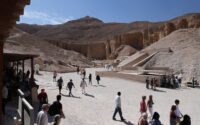Günter Brus, Viennese Actionist Who Used His Body to Break Taboos, Dies at 85
Günter Brus, one of the last surviving artists associated with the Viennese Actionism movement, died on Sunday in Graz at the age of 85.
News of the artist’s death was confirmed on Monday by Kunsthaus Bregenz, a contemporary art in Austria, just a week before the institution was to open a 500-work Brus survey. Thomas D. Trummer, the Kunsthaus Bregenz’s director, described Brus as a “poet, intellectual—and visionary” in a statement.
Brus was among the Viennese Actionists who used their bodies in controversial ways, staging performances that were intended as provocations for an increasingly conservative Austria.
In 1968, Brus and other Actionists staged a performance at the University of Vienna that is now dubbed Art and Revolution. As part of the piece, which was staged in public, Brus sang the national anthem while engaging in a sequence of shocking acts that involved self-harm, sex, and his own bodily excrement. He was prosecuted for “degrading symbols of the state,” and fled to Berlin with his family in the aftermath.
In a 2018 profile in the New York Times, Brus described that period in Vienna as “not a police state but close enough.”
Two years later, while living in Berlin, the artist enacted The Real Test, in which he cut himself with a razor. The piece only ended after he had beaten himself to the point of exhaustion.
His wife, Anna Brus, a Croatian immigrant, collaborated as a performer in some of his 1960s pieces, which were sometimes violent and often involved nudity; she was also included in pieces carried out by their peers Hermann Nitsch and Rudolf Schwarzkogler.
Born in 1938 in Mureck, near the southeastern border of Austria, Brus studied painting in Vienna in the mid-1950s. After being drafted to the military for a brief period in 1961, he returned to art-making a year later.
In 2018, when curators at the Belvedere 21, a contemporary art museum in Vienna, staged a major show dedicated to Brus to honor his 80th birthday, a catalog note said he’d broken down barriers for women artists like Valie Export, who used her body that were intended to shock.
In the 1970s to 1980s, Grus continued his artistic practice outside Vienna, participating in three editions of Documenta in Kassel, Germany, and eventually pivoting to drawing. In 1987, he produced a special pavilion titled Delyrium for the now-reprised amusement park Luna Luna that incorporates Nitsch’s organ music. The first iteration of the park opened in Hamburg, Germany.
But there was a sense among some critics that certain audiences still could not stomach Brus’s performances, for his work has not been widely seen in some locales. In a 1999 review, Barry Schwabsky suggested wrote that Brus’s 1960s performances may have remained too “visceral” for US audiences.



